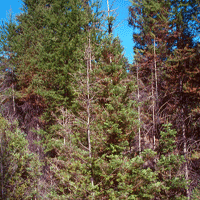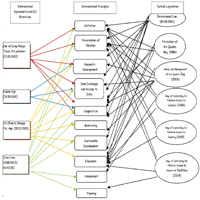
The importance of forest type when incorporating forest edge deposition in the evaluation of critical load exceedance
K Wuyts , A De Schrijver, K Verheyen
iForest - Biogeosciences and Forestry, Volume 2, Issue 1, Pages 43-45 (2009)
doi: https://doi.org/10.3832/ifor0486-002
Published: Jan 21, 2009 - Copyright © 2009 SISEF
Short Communications
Collection/Special Issue: Cost Action E29 Meeting 2008 - Istanbul (Turkey)
Future Monitoring and Research Needs for Forest Ecosystems
Guest Editors: Marcus Schaub (WSL, Birmensdorf, CH)
Abstract
This paper provides an assessment of the effect of incorporating edge deposition in the evaluation of critical load exceedance in forests, taking into account pollutant type, meteorological conditions, edge orientation, and forest type. In particular we have calculated critical load exceedance in five Flemish regions differing in forest fragmentation extent and/or share of coniferous forest.
Keywords
Forest edge, Edge effect, Exceedance of critical load, Forest type, Fragmentation
Authors’ Info
Authors’ address
A De Schrijver
K Verheyen
Laboratory of Forestry, Department of Forest and Water Management, Faculty of Bioscience Engineering, Ghent University. Geraardsbergsesteenweg 267, B-9090 Gontrode-Melle (Belgium)
Corresponding author
Paper Info
Citation
Wuyts K, De Schrijver A, Verheyen K (2009). The importance of forest type when incorporating forest edge deposition in the evaluation of critical load exceedance. iForest 2: 43-45. - doi: 10.3832/ifor0486-002
Academic Editor
Marcus Schaub
Paper history
Received: Jun 19, 2008
Accepted: Dec 09, 2008
First online: Jan 21, 2009
Publication Date: Jan 21, 2009
Publication Time: 1.43 months
Copyright Information
© SISEF - The Italian Society of Silviculture and Forest Ecology 2009
Open Access
This article is distributed under the terms of the Creative Commons Attribution-Non Commercial 4.0 International (https://creativecommons.org/licenses/by-nc/4.0/), which permits unrestricted use, distribution, and reproduction in any medium, provided you give appropriate credit to the original author(s) and the source, provide a link to the Creative Commons license, and indicate if changes were made.
Web Metrics
Breakdown by View Type
Article Usage
Total Article Views: 55414
(from publication date up to now)
Breakdown by View Type
HTML Page Views: 46179
Abstract Page Views: 3606
PDF Downloads: 4384
Citation/Reference Downloads: 82
XML Downloads: 1163
Web Metrics
Days since publication: 6176
Overall contacts: 55414
Avg. contacts per week: 62.81
Citation Metrics
Article Citations
Article citations are based on data periodically collected from the Clarivate Web of Science web site
(last update: Mar 2025)
Total number of cites (since 2009): 4
Average cites per year: 0.24
Publication Metrics
by Dimensions ©
Articles citing this article
List of the papers citing this article based on CrossRef Cited-by.
References
Digitale versie van de Bosreferentielaag van Vlaanderen [Digital forest cover map of Flanders]. OC GIS-Vlaanderen, Brussels, Belgium.
Gscholar
Intensieve monitoring van het bosecosysteem in het Vlaamse Gewest. Technisch rapport, eindverslag 2004, meetjaar 2003 [in Dutch]. IBW, Geraardsbergen, Belgium.
Gscholar
Berekening en kartering van kritische lasten en overschrijdingen voor verzuring en eutrofiëring in bosecosystemen in Vlaanderen. In: “Bepaling van de verzurings- en vermestingsgevoeligheid van Vlaamse bossen met gemodelleerde depositiefluxen. Eindverslag van project VLINA 98/01” (Neirynck J, De Ridder K, Langouche D, Wiedeman T, Kowalski A, Ceulemans R, Mensink C, Roskams P, Van Ranst E eds) [in Dutch]. IBW, Geraardsbergen, Belgium, pp. 44-100.
Gscholar
Numerisch Simulationen zum Einfluss von Waldbestandsinhomogenitäten auf die Windverhältnisse un die trockene Spurenstoffdeposition. PhD thesis, University of Hannover, Institute for Meteorology and Climatology, pp. 100.
Gscholar

















